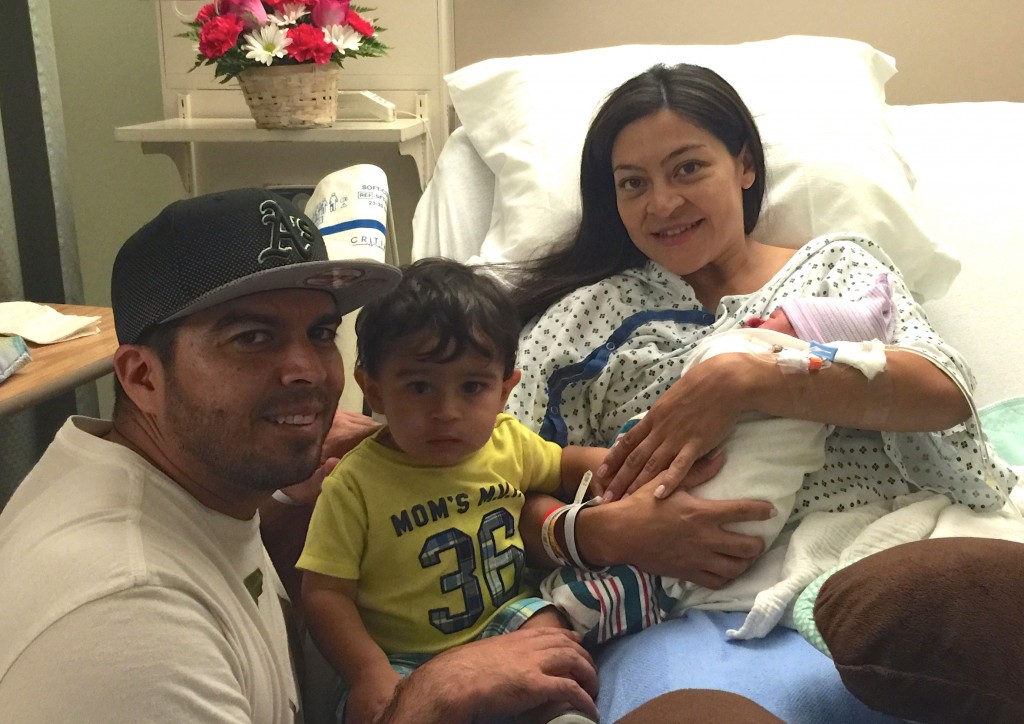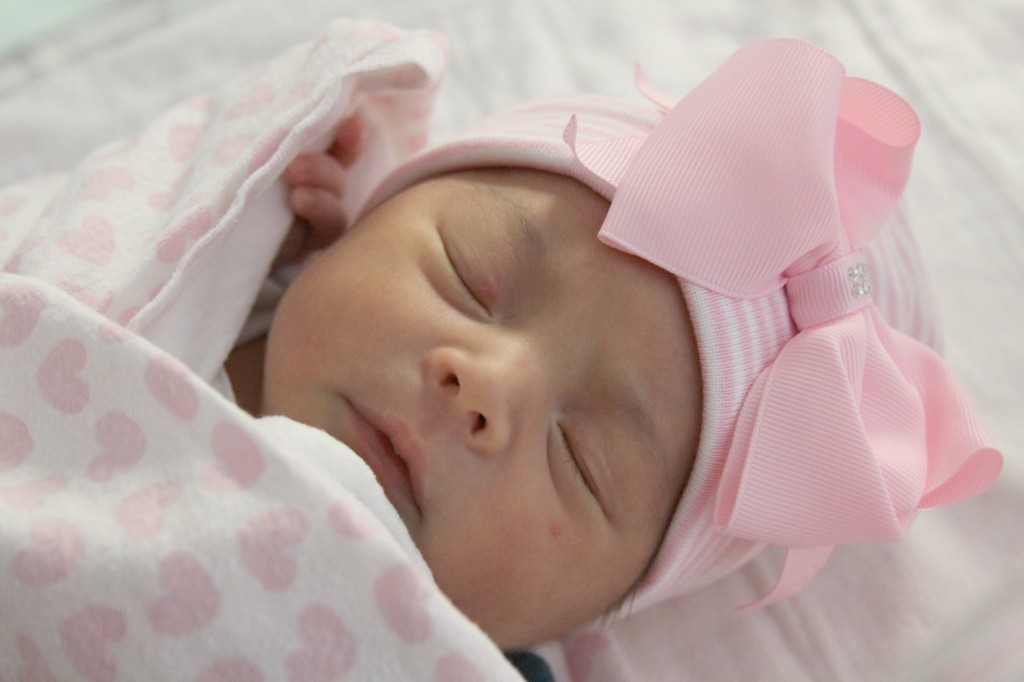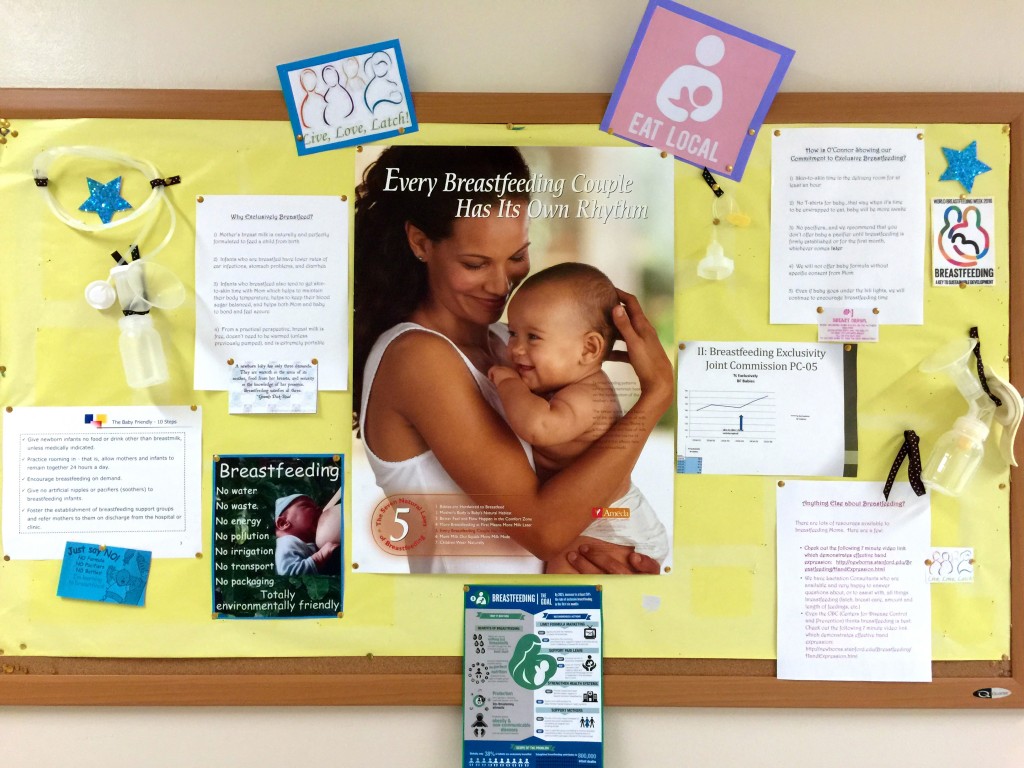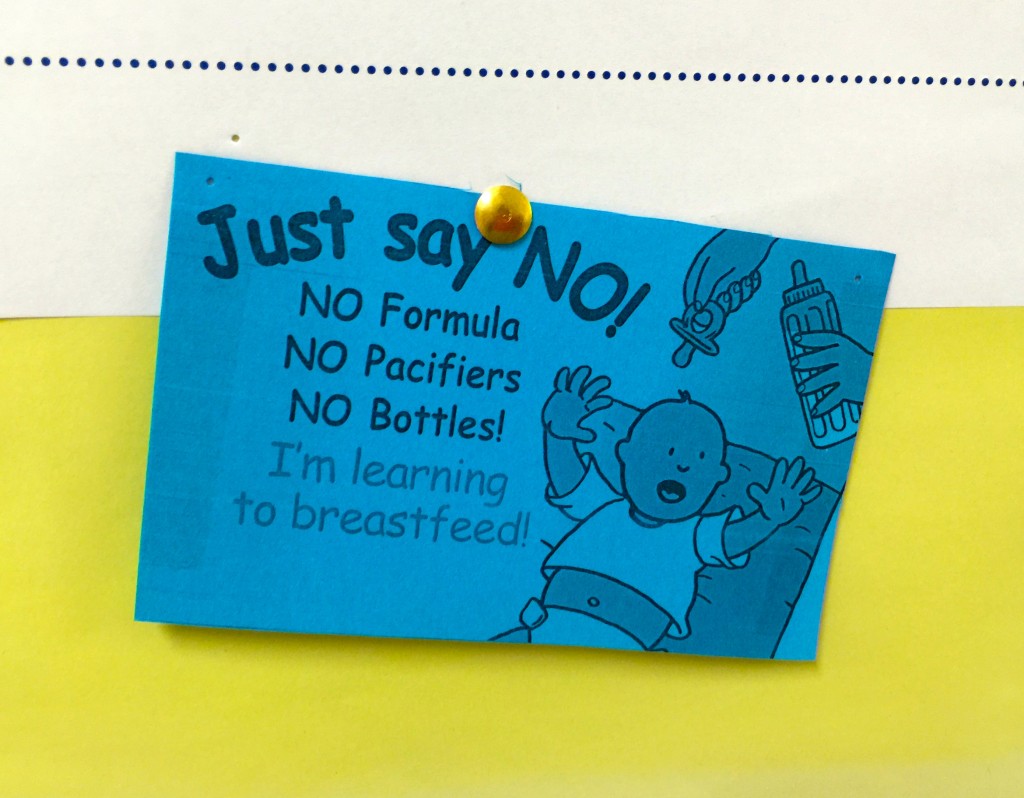
by Perlita R. Dicochea, Ph.D.
It’s been three months since my second child was born at 6 pounds, 12 ounces and by November 28th she weighed in at 12 pounds, 8 ounces. Although I just read a blog about how ounces are not a measure of breastfeeding success, and I agree, the weight loss and gain of a newborn means everything the first few days. In my observation, the amount of crying my first child engaged in at the hospital became directly correlated with how well he was being nourished.
I previously wrote about my experience at O’Connor Hospital, located in West San Jose, after the delivery of my first-born – the central theme being the mixed messages I received from hospital staff about my decision to exclusively breastfeed my baby, particularly upon hearing him cry and cry.
Before the birth of my second child, O’Connor began its transition from a private Catholic hospital to a non-profit in the process of meeting the “ten steps” that characterize a Baby-Friendly hospital, which every hospital in California is mandated to meet by January 1, 2025. (See California Health and Safety Code 123367 at http://leginfo.legislature.ca.gov/faces/codes_displaySection.xhtml?sectionNum=123367.&lawCode=HSC).
Baby-Friendly certification, or meeting its ten steps, signifies that a hospital’s environment is conducive to exclusive breastfeeding. Among other things, the steps include:
Helping mothers initiate breastfeeding within one hour of birth;
Showing mothers how to breastfeed and how to maintain lactation, even if they are separated from their infants;
Giving infants no food or drink other than breast-milk, unless medically indicated;
Encouraging breastfeeding on demand; and
Giving no pacifiers or artificial nipples to breastfeeding infants.*
Megan Gillespie, Director of Women’s and Children’s Services, who joined O’Connor in March of last year and is one of the key person’s implementing Baby-Friendly changes, notes that by April O’Connor recorded a spike in the number of mothers exclusively breastfeeding while in postpartum recovery, which occurred just a few months after beginning to implement the ten steps.
Gillespie furthers, “[O’Connor Hospital’s] goal is to provide the best quality and evidence-based care without losing the intimate relationship with the community that O’Connor is known for.” Gillespie emphasizes, “True success [to implementing the ten steps] requires our front-line nurses’ commitment to delivering the support and education to empower our patients to make informed choices regarding their infant’s feeding method.”

Here is a list of how O’Connor’s transition toward Baby-Friendly-ness are reflected in my own experience upon giving birth to my daughter in September of 2016, as compared to the birth of my baby boy in May of 2015:
1. First-born: After the doctors pulled my baby boy out of my tummy I waited and waited and waited some more before seeing him. I was not given the opportunity of skin-to-skin nurturing until I was wheeled into the recovery room for cesarean births, where they check one’s bleeding for an hour to ensure everything is ok.
Second-born: Immediately upon birth, a nurse carried my baby girl over to my side of the curtain so I could see her – all gooey and bloody and purple-blue. Soon after that moment, a nurse brought her over, still pretty gooey, to rest on me just below my neck (it’s what can be done with a cesarean set-up). In three words I borrow from Jennifer Lopez about one of her weddings, “It was magical.” In all seriousness, these moments are the most memorable for me.
2. First-born: The nurses were good about asking if I wanted to see a lactation consultant. One consultant came on day two for an hour-length tutorial and another came on day four, just before discharge. It was very helpful, however….
Second-born: Lactation consultants came to my room multiple times each day. Their encouragement was important for my self-confidence, even with the experience I had under my belt having nursed my first-born for over 12 months.
I have to admit, in spite of the successful breastfeeding story with my first child, I struggled to get my baby girl in the right position because physically I was compromised from the cesarean. Since I knew this time around how important it is for a newborn to be at the breast as much as possible those first few days, that’s what I did even when she wasn’t latching on correctly each time. The end result was a painful learning curve, similar to what I had experienced with my first-born. But we made it through and this time my milk supply increased in volume by day three instead of day four. Hallelujah!
3. First-born: Even though I resisted supplementation and was not told it was medically necessary, I was sent home with a hefty stash of formula. At the time, I thought it was a wonderful, precious gift – in case breastfeeding didn’t go as planned.
Second-born: The only hefty stash I was sent home with was in my nursing sports bra. Indeed, my take-home tote was rather light.
4. First-born: I received several-too-many nonverbal messages from nurses clearly dismayed that I was choosing to continue exclusively breastfeed my very unhappy, crying newborn. Seeing my desperation to find a way to sooth my baby (I should have just nursed him more) one nurse gave me a pacifier.
Second-born: No one hinted that I should supplement – my baby girl was very calm, thank goodness, perhaps in part because I nursed her more. But on day three she had orange crystals in her diaper, after which one nurse told me not to let my baby “use [me] as a pacifier.” Did that comment imply that non-nutritive sucking is what pacifiers are for and, subsequently, that I should be using one? Or, maybe I should control my baby’s nursing time? More importantly, I was unclear about how significant of an issue these orange crystals were, which was worrisome. A few hours later, a lactation consultant assured me that my baby really just needed a drink.
5. First-born: The hospital provided long sleeve tops for newborns, which all of the nurses used, providing an barrier to skin-to-skin throughout the hospital stay. At this stage of my career as a mother, I didn’t realize how important it was to continue having skin-to-skin contact with my newborn after day one.
Second-born: By this time, I was well aware that I needed to have more skin-to-skin time with my baby beyond the first hour and the hospital encouraged this by doing away with the tops. This way, babies only need to be unwrapped from the hospital blankets before nestling into mother’s skin.

6. First-born: Even though I can understand that nurses have a tough job and they each have multiple patients to look after in a short amount of time, every now and then I couldn’t help but feel like I was being tended to by robots, which made things cold and lonely.
Second-born: Overall, the interactions I had with nurses and other staff made them all seem much more human and I learned that many of them are very passionate about their vocation. I have to add that almost all of them knew about my first story and must have gathered that I might decide to write about them again.
7. First-born: The hospital’s breastfeeding support group was critical to my successful long-term exclusive breastfeeding goals and the weekly weigh-ins did much to ease any worries about my son’s weight gain.
Second-born: Although it’s more challenging to attend every week with two little ones under 18 months, the support group continues to be an important part of successful long-term exclusive breastfeeding. And knowing the weight of my baby in between pediatric visits is one reassuring measure that things are going well.
8. First-born: I was assigned a tiny room.
Second-born: I thought I was receiving special treatment not having to share a double room. I was later told that the room I was given is standard protocol for cesarean births.
9. First-born: My first doctor had agreed to wait before cutting my son’s umbilical cord. I don’t know if that happened.
Second-born: I heard the doctor tell his assistants to wait a minute before cutting my daughter’s cord. Although not a prerequisite for baby-friendliness, it was an important detail that improved my cesarean birth experience and potentially my baby’s health.
10. First-born: My favorite item on the menu was the chocolate cake.
Second-born: My favorite item on the menu was still the chocolate cake.
The last three points have nothing to do with the ten steps, but they were important aspects of my experience nonetheless. Moreover, if O’Connor’s rapid changes are any indication of the progress elsewhere, many mothers and new babies throughout California are certain to benefit from the mandate that all hospitals provide the environment, resources, and guidance needed to nourish newborns exclusively with mother’s milk.
Surely, increasing rates of exclusive breastfeeding beyond the hospital stay, especially once a mother goes back to work, may require a separate series of steps and serious cultural shifts – but it’s not impossible. In fact, O’Connor is just one example of what the right leadership can do in a short amount of time – matched with healthy teamwork and commitment by those on the front lines.
*See the info box for the complete list of steps and further information about the Baby-Friendly Hospital Initiative.

The Baby-Friendly Hospital Initiative’s Ten Steps
1. Have a written breastfeeding policy that is routinely communicated to all health care staff.
2. Train all health care staff in the skills necessary to implement this policy.
3. Inform all pregnant women about the benefits and management of breastfeeding.
4. Help mothers initiate breastfeeding within one hour of birth.
5. Show mothers how to breastfeed and how to maintain lactation, even if they are separated from their infants.
6. Give infants no food or drink other than breast-milk, unless medically indicated.
7. Practice rooming in – allow mothers and infants to remain together 24 hours a day.
8. Encourage breastfeeding on demand.
9. Give no pacifiers or artificial nipples to breastfeeding infants.
10. Foster the establishment of breastfeeding support groups and refer mothers to them on discharge from the hospital or birth center.
The Baby-Friendly Hospital Initiative was developed by the World Health Organization and the United Nation’s Children’s Fund in 1991 and includes the International Code of Marketing of Breast-milk Substitutes established in 1981. For more details visit http://www.babyfriendlyusa.org/about-us/baby-friendly-hospital-initiative and http://www.who.int/nutrition/publications/code_english.pdf.
Perlita Dicochea earned her Ph.D. in Ethnic Studies at U.C. Berkeley, M.A. in Communication Studies at Arizona State University, and B.A. in Communication Studies at Santa Clara University. She has been a professor of Ethnic Studies and Communication Studies since 1997 and has published original research about Chicana feminism and environmental justice issues. Dr. Dicochea is the mother of a 9-year-old chihuahua, 19-month-old boy and 3-month-old girl and is a Certified Lactation Educator Counselor. Visit her on Facebook at https://www.facebook.com/EverythingLactation.


